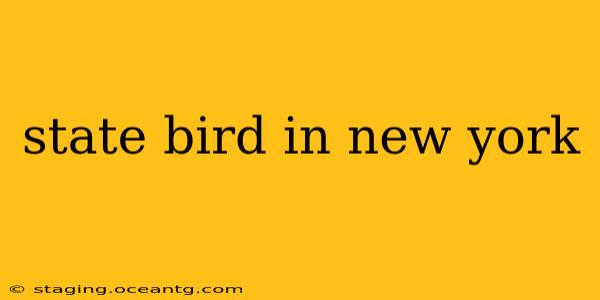New York's state bird, the Eastern Bluebird ( Sialia sialis), is a captivating sight, easily recognizable by its vibrant plumage and gentle demeanor. This small songbird, a symbol of the state since 1970, embodies the beauty and tranquility often associated with New York's diverse landscapes. But what makes this bird so special, and what's its story? Let's delve into the details.
Why Was the Eastern Bluebird Chosen as New York's State Bird?
The selection of the Eastern Bluebird wasn't arbitrary. Its striking beauty and widespread presence across the state made it a popular choice. The bird's cheerful song and relatively docile nature also resonated with New Yorkers, contributing to its symbolic significance. The campaign to make it the state bird gained momentum through grassroots efforts and widespread public support, reflecting the deep connection many felt with this charming creature.
What are the Characteristics of the Eastern Bluebird?
The Eastern Bluebird is a small bird, measuring around 6-8 inches in length. Males showcase a brilliant, rich blue on their upperparts, contrasting beautifully with their rusty-red breasts and flanks. Females exhibit a more subdued coloration, featuring a paler blue on their backs and a lighter, browner breast. Both sexes possess a short, slightly cocked tail and a delicate, slender build. Their song is a soft, melodious warble, often described as a sweet and gentle melody.
What Does the Eastern Bluebird Eat?
Eastern Bluebirds are insectivores, meaning their primary diet consists of insects. They are highly effective at controlling insect populations, consuming a variety of beetles, grasshoppers, caterpillars, and other invertebrates. During the colder months, they may supplement their diet with berries and other fruits. Their foraging behavior often involves perching on elevated spots, scanning the ground for prey before swooping down to capture it.
Where Does the Eastern Bluebird Live?
Eastern Bluebirds are found throughout New York State, inhabiting a variety of habitats including open fields, meadows, orchards, and woodland edges. They prefer areas with scattered trees or shrubs providing nesting sites and perching locations. Their adaptability allows them to thrive in both rural and suburban environments, provided suitable nesting cavities are available.
What are the Threats to the Eastern Bluebird Population?
Despite their adaptability, Eastern Bluebirds face several threats. Habitat loss due to urbanization and agricultural expansion is a significant concern. Competition with non-native species, such as the European Starling, for nesting sites also impacts their population. Pesticides and other environmental pollutants can negatively affect their health and reproduction. Conservation efforts, including the installation of nest boxes, play a crucial role in protecting this beautiful bird and ensuring its continued presence in New York.
How Can I Help Protect Eastern Bluebirds?
You can contribute to Eastern Bluebird conservation by taking simple steps. Installing nest boxes in your yard provides safe nesting sites, reducing competition for natural cavities. Minimizing pesticide use protects them from harmful chemicals. Supporting organizations dedicated to bird conservation and habitat preservation further assists in their protection. By understanding and appreciating these beautiful birds, we can collectively ensure their survival in New York's diverse ecosystem.
What Other Birds Are Found in New York?
New York's diverse ecosystems support a wide array of bird species. From the majestic Bald Eagle to the tiny hummingbird, the state's avian population is rich and varied. Specific species present will depend on the region and habitat, but exploring local birdwatching resources will reveal the rich diversity of birds found across the state.
In conclusion, the Eastern Bluebird's designation as New York's state bird is a testament to its beauty, prevalence, and ecological significance. Understanding its habits, threats, and conservation needs allows us to appreciate and protect this charming avian symbol of the state.
